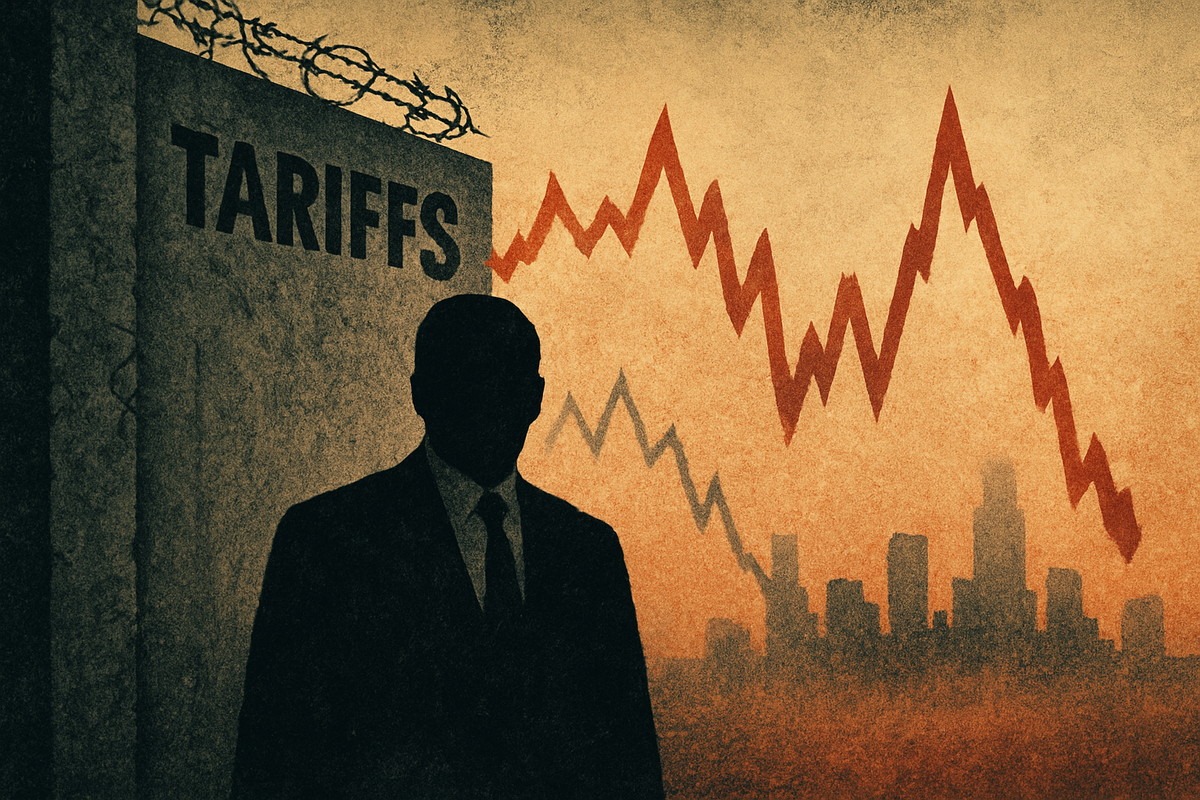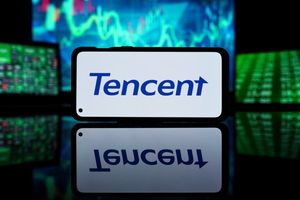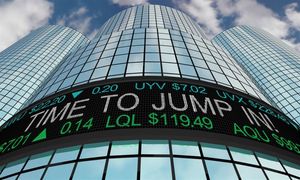
Economists and investors are increasingly sounding the alarm over the growing risk of "stagflation," a perilous economic phenomenon characterized by high inflation coupled with stagnant economic growth. At the heart of these concerns are the tariff policies enacted by former President Donald Trump, which many experts fear could simultaneously drive up consumer prices and stifle economic expansion, creating a challenging environment for businesses, consumers, and policymakers alike. This looming threat has significant implications for the broader market, potentially ushering in a period of heightened volatility and uncertainty.
The immediate implications of this potential economic storm are profound. Businesses face rising input costs and diminished consumer demand, while households grapple with eroding purchasing power. The Federal Reserve finds itself in a precarious position, with traditional monetary policy tools proving less effective in combating both inflation and stagnation simultaneously. As the global economy remains interconnected, the ripple effects of U.S. tariff policies could extend far beyond national borders, impacting international trade relations and global supply chains.
Tariffs: A Double-Edged Sword Threatening Growth and Stability
The current apprehension stems directly from the mechanics of tariffs and their multifaceted impact on the economy. Tariffs, essentially taxes on imported goods, directly increase the cost of these products for importers. This cost is then largely passed on to consumers, leading to higher prices for a wide array of goods. For instance, a broad tariff on all U.S. trade partners could potentially increase consumer prices by 2.2%. Beyond direct price hikes, tariffs on intermediate goods and raw materials, such as steel or aluminum, inflate production costs for domestic manufacturers, which are then incorporated into the prices of finished goods. This reduction in competition from cheaper imports can also embolden domestic producers to raise their prices, further fueling inflationary pressures.
The timeline leading to this moment of heightened concern traces back to President Trump's initial imposition of tariffs on various goods, particularly those from China, under the guise of protecting domestic industries and addressing trade imbalances. These actions, often met with retaliatory tariffs from affected nations, have created a climate of trade uncertainty that has persisted. Key players involved include the U.S. administration, particularly the Office of the United States Trade Representative (USTR), foreign governments, and multinational corporations heavily reliant on global supply chains. Initial market reactions have been mixed; while some sectors initially saw a boost from reduced foreign competition, the broader market has shown signs of unease, with manufacturing jobs declining for three consecutive months, consistent with trade uncertainty depressing hiring willingness.
The stagnation aspect of the stagflation equation is equally concerning. As tariffs drive up prices, consumer purchasing power diminishes, leading to reduced spending—a critical driver of economic growth. The unpredictable nature of tariff policies also creates significant uncertainty for businesses, causing them to delay or scale back hiring and capital expenditure plans. This hesitation directly translates to a slowdown in overall economic expansion. Furthermore, tariffs can lead to job losses in industries reliant on imported materials or those facing retaliatory tariffs on their exports. Economists from institutions like Apollo, BMO Economics, and JPMorgan have explicitly warned that President Trump's tariffs increase the risk of the U.S. economy entering a period of stagflation, with Nobel laureate Paul Krugman also laying out a compelling case for this scenario.
Navigating the Economic Minefield: Winners and Losers Emerge
In a tariff-induced stagflationary environment, the economic landscape becomes a minefield, with distinct winners and losers emerging across various sectors. Companies with strong pricing power, essential services, and robust domestic production capabilities are better positioned to weather the storm, while those heavily reliant on global supply chains and discretionary consumer spending face significant headwinds.
Among the likely losers are companies in Retail and Consumer Discretionary sectors. As tariffs inflate the cost of imported goods, consumers face higher prices, while stagnant wages and rising unemployment erode their disposable income. This double whammy leads to decreased demand for non-essential items. Automobile manufacturers like Tesla (NASDAQ: TSLA) and General Motors (NYSE: GM) are particularly vulnerable, facing increased production costs from tariffs on materials like steel and aluminum, coupled with a decline in consumer demand for big-ticket purchases. Similarly, home improvement retailers such as Home Depot (NYSE: HD) and apparel and furniture retailers will likely see reduced spending as consumers tighten their belts.
Manufacturing and Industrials with complex global supply chains are also in the crosshairs. Companies like Caterpillar (NYSE: CAT), a manufacturer of heavy equipment, could see reduced demand if construction and mining activities slow due to broader economic stagnation and increased costs. Even companies with indirect exposure, such as Newell Brands (NASDAQ: NWL), have already cut earnings forecasts due to tariff-related expenses. High-growth technology companies, especially those dependent on imported hardware and chips, face headwinds. While some tech sub-sectors may be resilient, companies like Apple (NASDAQ: AAPL), with significant iPhone production in China, could see negative earnings growth due to tariffs. Tech giants like Microsoft (NASDAQ: MSFT), Amazon (NASDAQ: AMZN), and Meta (NASDAQ: META), which rely on imported chips for data centers, could also face substantial tariff impacts on critical components, threatening their long-term growth trajectories.
Conversely, certain sectors and companies are better positioned to navigate or even thrive during stagflation. Utilities companies, providing essential services with stable demand and often regulated pricing, offer a defensive haven for investors. NextEra Energy (NYSE: NEE), for example, benefits from consistent demand for its services, and its renewable energy projects may also be shielded from tariff impacts due to domestic supply chains. Consumer Staples companies, producing essential goods that consumers purchase regardless of economic conditions, tend to perform well. Walmart (NYSE: WMT), as a discount retailer, often sees increased sales as consumers seek value during economic downturns, while companies like Procter & Gamble (NYSE: PG) and Johnson & Johnson (NYSE: JNJ) benefit from inelastic demand for their everyday necessities and healthcare products.
Healthcare generally remains resilient due to the inelastic demand for its services and products. Companies like UnitedHealth (NYSE: UNH) and AstraZeneca (NASDAQ: AZN) provide essential healthcare, benefiting from consistent demand and the ability to absorb cost increases through insurance-based payment models. Domestic producers, particularly in industries facing high tariffs on imports, stand to gain. Steel and aluminum producers like Nucor (NYSE: NUE) and Cleveland-Cliffs (NYSE: CLF) have seen demand surge due to tariffs on foreign imports, allowing them to gain market share and boost margins. In the energy sector, while some sub-sectors face higher input costs from tariffs, major oil producers like ExxonMobil (NYSE: XOM) and Chevron (NYSE: CVX) can perform well as their products act as a hedge against inflation, especially if they have strong domestic drilling operations. Finally, Digital Economy and Software Companies like Adobe (NASDAQ: ADBE), Oracle (NYSE: ORCL), and Salesforce (NYSE: CRM), with minimal reliance on physical goods or manufacturing, are largely insulated from tariffs, and their strong balance sheets can provide resilience.
Industry Impact and Broader Implications: A Looming Economic Quagmire
The specter of tariff-induced stagflation extends far beyond immediate market reactions, fitting into and exacerbating several broader industry trends while creating significant ripple effects across competitive landscapes and partnerships. This complex economic challenge also presents a formidable dilemma for regulatory bodies and policymakers, drawing unsettling parallels to historical economic downturns.
One of the most significant broader industry trends impacted by tariffs is the disruption of global supply chains. Tariffs act as a direct tax on imports, inflating prices for businesses and consumers, which in turn forces companies to rethink their sourcing strategies. This often leads to shifts towards nearshoring or friend-shoring, as businesses seek to minimize geopolitical risks and supply disruptions. The increased cost of raw materials and components due to tariffs compels businesses to seek alternative, often more expensive, suppliers, a complex and costly undertaking. Industries heavily reliant on imported goods, such as electronics, machinery, and textiles, are particularly vulnerable to these price increases, leading to a re-evaluation of their entire operational models.
The ripple effects on competitors and partners are substantial. Tariffs directly increase input costs for manufacturers, squeezing profit margins across various sectors, including aluminum, steel, and automobiles. These higher costs are frequently passed on to consumers, leading to reduced purchasing power and a potential slowdown in demand. This dynamic can alter competitive landscapes, as suppliers from countries not subject to tariffs might gain an advantage, while businesses directly impacted may be forced to heavily discount their products to retain market share. The uncertainty generated by tariffs can also deter foreign direct investment and cause domestic companies to delay expansion plans, impacting overall economic growth and job creation. Furthermore, the imposition of tariffs often provokes retaliatory measures from affected trading partners, further complicating international trade and reducing the export competitiveness of the initiating country, leading to a "tit-for-tat" approach that can significantly decline global trade.
From a regulatory and policy standpoint, tariff-induced stagflation presents a profound dilemma for central banks. The Federal Reserve, for instance, faces the unenviable task of managing inflation partly driven by tariffs, while simultaneously contending with signs of weakening economic growth and a softening labor market. Traditional monetary policy tools are less effective in such an environment. Lowering interest rates, typically used to stimulate growth, could exacerbate inflation when prices are already rising due to tariffs. Conversely, raising interest rates to combat inflation could further slow economic growth and increase unemployment, creating a "stagflationary trap." Governments may also face pressure to implement fiscal policies that support affected industries and workers, such as subsidies or unemployment benefits, which could strain public finances.
Historical precedents offer sobering insights into the potential consequences. The Smoot-Hawley Tariff Act of 1930, which significantly raised U.S. tariffs on over 20,000 imported goods, is widely cited as a principal cause of the worsening Great Depression. It triggered widespread retaliatory tariffs, leading to a dramatic collapse in international trade and contributing to bank failures. More recently, the 1970s stagflation, characterized by simultaneous high inflation, high unemployment, and stagnant economic growth, largely driven by oil price shocks, provides another relevant comparison. Like oil price shocks, tariffs act as a supply-side shock by increasing the cost of production inputs, leading to higher prices and reduced output. The 1970s demonstrated the difficulty central banks faced in addressing both inflation and stagnation simultaneously, as traditional tools proved ineffective. The current environment, with tariffs potentially adding $200 billion annually to U.S. input costs, draws direct parallels to the inflationary pressures seen in the 1970s.
What Comes Next: Navigating the Uncharted Waters of Stagflation
The path forward in a tariff-induced stagflationary environment is fraught with uncertainty, demanding strategic pivots from businesses, a delicate balancing act from policymakers, and heightened vigilance from investors. Both short-term and long-term possibilities paint a challenging picture, with potential scenarios ranging from a prolonged "stagflation lite" to a full-blown recession coupled with surging inflation.
In the short term, consumers should brace for rising prices as businesses pass on increased costs from tariffs. Estimates suggest an additional $2,400 in annual costs for the average U.S. household due to recent tariffs, which have pushed the average effective tariff rate to its highest since 1934. The labor market is also likely to weaken, with businesses scaling back hiring or even resorting to layoffs in industries sensitive to tariffs, such as manufacturing, retail, wholesale, and construction. This combination of increased costs and reduced consumer purchasing power will likely lead to a deceleration in GDP growth, with some economists already observing a "mild form of stagflation." The Federal Reserve faces an unenviable dilemma: raising interest rates to combat inflation risks further stifling economic growth, while cutting rates to stimulate the economy could worsen inflation. This uncertainty will likely lead to increased business uncertainty, deterring foreign direct investment and causing domestic companies to delay long-term planning.
If a tariff-induced stagflationary environment persists, the long-term outlook includes the risk of entrenched inflation, potentially fostering a "wage-price spiral" where workers demand higher wages to cope with rising costs, leading businesses to further increase prices. This could result in sustained economic stagnation or even a full-blown recession combined with high inflation, a scenario considered worse than a typical downturn. Supply chain restructuring and fragmentation are also likely, as businesses seek to diversify their sourcing away from heavily tariffed countries, a costly and time-consuming process. This could also lead to reduced international competitiveness for a nation's exports. Overcoming entrenched stagflation typically requires "draconian measures," such as very high interest rates, as seen in the 1970s, which can lead to painful recessions.
Strategic pivots and adaptations will be crucial for all stakeholders. Businesses will need to carefully manage costs and adjust pricing, potentially absorbing higher input prices initially but eventually passing them on to consumers, especially in sectors with thin margins. Diversifying supply chains to reduce reliance on heavily tariffed imports or "reshoring" production domestically will become paramount. Investing in automation and technology to improve efficiency and reduce labor costs can also mitigate some inflationary pressures. The Federal Reserve will continue to face the unenviable choice between fighting inflation and supporting growth, with their decisions heavily scrutinized and a risk of exacerbating one problem while trying to fix the other. Governments may also face pressure to implement fiscal policies that can counteract the negative effects of tariffs without fueling inflation further, a challenge given existing high deficits.
Market opportunities and challenges will emerge from this environment. Broad market declines are a significant challenge, as both stocks and bonds may decline simultaneously. Industries heavily reliant on imports or exports are likely to underperform, and businesses with thin profit margins will struggle to pass on increased costs. However, opportunities may arise in defensive sectors less sensitive to economic cycles and with inelastic demand, such as healthcare and utilities, which may offer relative stability. Government-led infrastructure initiatives could provide a structural tailwind for construction, logistics, and steel fabrication. Certain technology companies, particularly those providing "business staples" like cloud services, may also prove resilient. Investors may seek refuge in inflation hedges such as Treasury Inflation-Protected Securities (TIPS), commodities like gold and copper, and Real Estate Investment Trusts (REITs). Dividend-paying stocks in less tariff-sensitive sectors can also provide income in a volatile market.
Potential scenarios range from a persistent "stagflation lite," where inflation remains above target while job growth slows significantly, to a "stagflationary trap" where Fed rate cuts fail to significantly boost the economy while tariffs keep inflation elevated. The worst-case scenario involves a recession with high inflation, where escalating trade tensions and supply shocks lead to a sharp economic contraction coupled with surging inflation, potentially causing significant declines in equity markets. A trade war escalation, with further intensified tariffs, could lead to more severe global economic slowdowns and increased supply chain fragmentation. However, a more optimistic, though challenging, scenario involves gradual adaptation and mitigation, where businesses and supply chains adjust to the new tariff landscape, combined with careful monetary and fiscal policy, eventually leading to a "soft landing" where inflation cools and growth stabilizes.
Conclusion: A Precarious Balance and the Road Ahead
The growing concerns about tariff-induced stagflation represent a critical juncture for the U.S. and global economies. The confluence of rising inflation due to increased import costs and stagnant economic growth stemming from business uncertainty and reduced consumer spending creates a precarious balance that defies easy solutions. The immediate implications are already being felt in the form of higher consumer prices and a weakening labor market, with the Federal Reserve facing an unprecedented challenge in navigating this complex economic landscape.
Looking ahead, the market will continue to be shaped by the interplay of these forces. Investors should closely monitor inflation data, employment figures, and consumer spending trends for signs of either deepening stagnation or persistent inflationary pressures. The strategic pivots undertaken by businesses, particularly in supply chain diversification and pricing strategies, will be crucial in determining their resilience. Furthermore, the policy responses from the Federal Reserve and the government will be paramount. Any further escalation of trade tensions or a failure to address the underlying causes of inflation could push the economy further into a stagflationary trap, with potentially severe consequences for corporate earnings and overall market valuations.
The historical precedents of the Smoot-Hawley Tariff Act and the 1970s stagflation serve as stark reminders of the potential for protectionist policies to trigger global trade wars and for supply-side shocks to create persistent inflationary pressures alongside stagnant growth. While the current situation may not mirror these historical events precisely, the underlying mechanisms are eerily similar. The lasting impact of this period will depend on the ability of policymakers to implement effective strategies that address both inflation and economic stagnation without exacerbating either. For investors, a defensive posture, with a focus on sectors less sensitive to economic cycles and those with strong pricing power, may prove prudent in the coming months. The road ahead is uncertain, but understanding the dynamics of tariff-induced stagflation will be key to navigating its challenges and identifying potential opportunities.





